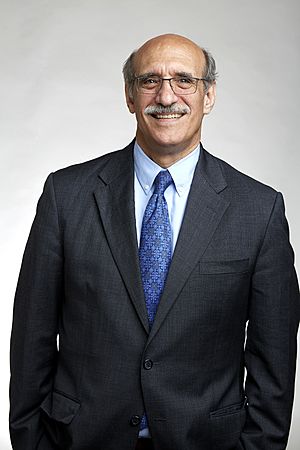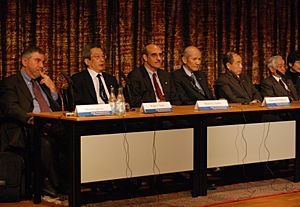Martin Chalfie facts for kids
Quick facts for kids
Martin Chalfie
|
|
|---|---|

Chalfie in 2018
|
|
| Born |
Martin Lee Chalfie
January 15, 1947 Chicago, Illinois, U.S.
|
| Citizenship | American |
| Education | Harvard University (BA, PhD) |
| Known for | Green fluorescent protein |
| Spouse(s) | Tulle Hazelrigg |
| Awards | E. B. Wilson Medal (2008) Nobel Prize in Chemistry (2008) Golden Goose Award (2012) Foreign Member of the Royal Society (2018) Lomonosov Gold Medal (2018) |
| Scientific career | |
| Fields | Neurobiology |
| Institutions | Columbia University Laboratory of Molecular Biology University of Cambridge |
| Thesis | Regulation of catecholamine biosynthesis and secretion in a rat pheochromocytoma (1977) |
| Doctoral advisor | Robert L. Perlman |
Martin Lee Chalfie (born January 15, 1947) is an American scientist. He is a professor at Columbia University. In 2008, he won the Nobel Prize in Chemistry. He shared this award with Osamu Shimomura and Roger Y. Tsien. They were honored for finding and developing the green fluorescent protein, known as GFP. This special protein helps scientists see things inside living cells.
Contents
Early Life and School Days

Martin Chalfie grew up in Chicago, Illinois. His father was a guitarist, and his mother owned a clothing store. His grandparents came to the U.S. from places like Moscow and Brest-Litovsk.
In 1965, he started studying at Harvard University. He first planned to study math. But he soon changed his mind to biochemistry. This field combined his love for chemistry, math, and biology.
During college, he worked in a lab one summer. It was a tough experience, and he felt like he wasn't good at biology. So, in his last year, he took classes in law, theater, and Russian literature.
A Champion Swimmer
Martin Chalfie was also a great swimmer at Harvard. He became the team captain in his senior year. His coach said he would be an excellent leader. He won a special award for leadership and teamwork. Even after winning the Nobel Prize, he often said he was a swimmer first.
After graduating in 1969, he worked different temporary jobs. He sold dresses for his parents' business. He also taught at a school in Connecticut. In 1971, he did research at Yale University. This work led to his first published paper. It gave him confidence to go back to school. He returned to Harvard and earned his PhD in 1977.
Discovering Green Fluorescent Protein
After getting his PhD, Dr. Chalfie did more research. He worked at the Laboratory of Molecular Biology (LMB). There, he studied tiny worms called C. elegans. These worms are often used in science because they are simple.
In 1982, he joined Columbia University. He continued to study these worms. He focused on how their nerve cells work.
The Big Idea
Dr. Chalfie's most famous work started in 1988. He attended a talk about creatures that glow in the dark. This sparked an idea. He wondered if he could use the glowing protein from jellyfish. This protein is called green fluorescent protein (GFP). He thought it could help scientists see inside cells.
In 1992, he did important experiments. He showed that GFP could be used as a marker. This meant scientists could attach GFP to other proteins. Then, they could watch these proteins move and work inside living cells. This was a huge step for biology. His paper on GFP is one of the most cited in its field. In 2012, he received the Golden Goose Award for this amazing discovery.
Life and Achievements
Martin Chalfie married Tulle Hazelrigg, who is also a scientist. She later joined him as a professor at Columbia University. They have a daughter named Sarah, born in 1992.
In 2004, Dr. Chalfie was chosen to be part of the United States National Academy of Sciences. This is a very high honor for scientists.
The Nobel Prize Call
When the Nobel Prize Committee called him in 2008, he was asleep! He woke up and wondered who had won the prize. He checked the Nobel Prize website and found out it was him!
In 2015, Dr. Chalfie signed an important declaration. It was about Climate Change. Many Nobel Prize winners signed it. They wanted to encourage world leaders to take action. This declaration was given to the President of France. It helped with the COP21 climate summit in Paris.
Dr. Chalfie's lab still uses C. elegans worms. They study how nerve cells grow and work. He has published over 100 scientific papers. Many of these papers have been cited by other scientists hundreds of times.
In 2023, he received an honorary degree in physics. This was from the University of Parma in Italy.
See also
 In Spanish: Martin Chalfie para niños
In Spanish: Martin Chalfie para niños
- List of Jewish Nobel laureates

